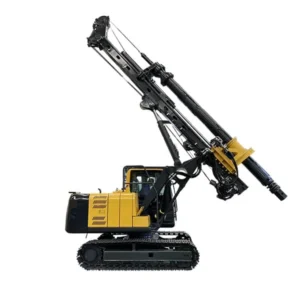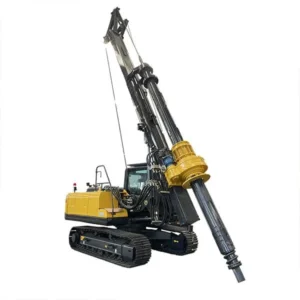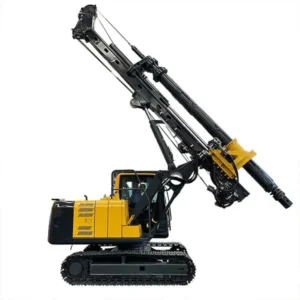Welcome to My Blog!
Before we dive into the content, I’d love for you to join me on my social media platforms where I share more insights, engage with the community, and post updates. Here’s how you can connect with me:
Facebook:https://www.facebook.com/profile.php?id=100066759548969
Now, let’s get started on our journey together. I hope you find the content here insightful, engaging, and valuable.
معرفی
Rotary drilling rigs are complex machines used in the drilling of wells for oil, gas, water, and other resources. The efficiency and effectiveness of these rigs depend largely on the quality and functionality of their components. Understanding the various rotary drilling rig parts and how they interact is crucial for operators, engineers, and maintenance teams to ensure optimal performance and longevity of the equipment. This comprehensive guide will explore the essential rotary drilling rig parts, their roles, and how they contribute to the overall drilling process.
Overview of Rotary Drilling Rig Parts

Key Components of a Rotary Drilling Rig
A rotary drilling rig is composed of multiple parts, each playing a specific role in the drilling process. Here, we break down the main components:
- Drill String: This is a column, or string, of drill pipes connected together, that transmits drilling fluid to the drill bit. The drill string also provides mechanical energy to the drill bit to enable it to break the rock.
- Drill Bit: The drill bit is the cutting tool used to break up the rock formations. It is located at the bottom of the drill string and comes in various types depending on the material being drilled.
- Rotary Table: The rotary table is a component that drives the rotation of the drill string. It is typically located on the rig floor and is powered by the rig’s engine.
- Mud Pump: This pump circulates drilling fluid (or mud) down through the drill string, out of the drill bit, and back up the wellbore. This fluid cools the drill bit, carries cuttings back to the surface, and stabilizes the wellbore.
- Derrick/Mast: The derrick is a tall structure that supports the drill string and other equipment above the wellbore. It provides the height necessary to lift and lower the drill string and other equipment into and out of the wellbore.
- Top Drive: This is a motor system that is used to rotate the drill string and can move vertically along the derrick. The top drive offers greater control over the drilling process compared to the rotary table.
- Blowout Preventer (BOP): This safety device is installed on the wellhead and is used to control the pressure within the wellbore. It prevents blowouts by sealing, controlling, and monitoring the well.
These parts work together to create a powerful and efficient drilling system, with each component playing a critical role in the overall operation.
In-Depth Look at Key Rotary Drilling Rig Parts
Drill String and Drill Pipes
The drill string is a crucial component of the rotary drilling rig, as it connects the rig on the surface to the drill bit deep in the wellbore. The drill string is composed of several connected sections of drill pipes. These pipes are typically made of high-strength steel or aluminum alloys and are designed to withstand the extreme forces encountered during drilling.
- Function: The drill string transmits rotary motion from the surface to the drill bit, and it also serves as a conduit for drilling fluid.
- نگهداری: Regular inspection for wear and tear, as well as routine cleaning and lubrication, are essential to maintain the integrity and performance of the drill string.
Drill Bit Types and Functions
The drill bit is the cutting tool that is used to bore through rock and other subsurface materials. There are several types of drill bits, each suited to different geological conditions:
- Tricone Bits: These are one of the most common types of drill bits and are used for various formations. They consist of three rotating cones with cutting teeth.
- Diamond Bits: These bits are equipped with industrial diamonds on their cutting surfaces and are used for drilling through extremely hard rock formations.
- PDC Bits (Polycrystalline Diamond Compact): PDC bits use synthetic diamond materials and are highly durable, making them suitable for drilling through abrasive formations.
The selection of the drill bit depends on factors such as the type of rock, the desired drilling speed, and the overall drilling plan.
Rotary Table and Top Drive Systems
The rotary table and top drive are two critical components that facilitate the rotation of the drill string:
- Rotary Table: The rotary table is the traditional method of rotating the drill string. It uses a kelly bushing to rotate the kelly, which in turn rotates the drill string. The rotary table is robust and reliable, but it offers less control compared to modern systems.
- Top Drive: The top drive is a more advanced system that allows for continuous rotation of the drill string. It provides greater control, reduces the time required to make or break connections, and improves safety by reducing the need for manual handling of the drill string.
Both systems have their advantages, and the choice between a rotary table and a top drive depends on the specific needs of the drilling operation.
Importance of Mud Pumps in Rotary Drilling
Role of Mud Pumps
Mud pumps are essential for circulating drilling fluid throughout the drilling system. The drilling fluid, commonly referred to as “mud,” serves several important functions:
- Cooling the Drill Bit: As the drill bit grinds through rock, it generates a significant amount of heat. The drilling fluid cools the bit, preventing it from overheating and reducing wear.
- Carrying Cuttings to the Surface: The drilling fluid carries rock cuttings out of the wellbore, allowing them to be separated and removed at the surface.
- Stabilizing the Wellbore: The pressure exerted by the drilling fluid helps to stabilize the wellbore, preventing it from collapsing.
Types of Mud Pumps
There are two main types of mud pumps used in rotary drilling:
- Triplex Pumps: These pumps have three pistons and are the most commonly used in modern drilling operations due to their efficiency and ability to handle high pressures.
- Duplex Pumps: Duplex pumps have two pistons and are less common but still used in certain applications. They are simpler in design and can be more cost-effective for certain operations.
Maintaining the mud pumps is critical to ensure that they operate efficiently and reliably throughout the drilling process.
Table of Key Rotary Drilling Rig Parts and Their Functions
The following table summarizes the key rotary drilling rig parts discussed in this guide, along with their primary functions:
| Part | Function | Maintenance Requirements |
|---|---|---|
| Drill String | Transmits rotary motion, delivers drilling fluid | Regular inspection, cleaning, lubrication |
| Drill Bit | Cuts through rock formations | Regular replacement based on wear, proper selection |
| Rotary Table | Rotates the drill string via the kelly bushing | Routine inspection, lubrication |
| Top Drive | Provides continuous rotation and greater control | Regular maintenance, inspection of drive components |
| Mud Pump | Circulates drilling fluid through the system | Regular maintenance, monitoring of fluid levels |
| Derrick/Mast | Supports the drill string and other equipment | Structural inspections, bolt tightening |
| Blowout Preventer | Controls well pressure, prevents blowouts | Regular testing, seal inspection |
Common Issues and Troubleshooting for Rotary Drilling Rig Parts

Wear and Tear on Drill Bits
One of the most common issues encountered in rotary drilling is the wear and tear on drill bits. Continuous drilling through hard formations can cause significant wear on the cutting surfaces of the bit, leading to reduced efficiency and slower drilling rates.
- Troubleshooting: Regular inspection and timely replacement of the drill bit are essential. Monitoring drilling speed and torque can help detect when a bit is becoming worn.
Mud Pump Failures
Mud pumps are critical to the drilling process, and failures can lead to significant downtime. Common issues include piston wear, valve failures, and leaks in the fluid system.
- Troubleshooting: Regular maintenance and inspection of the mud pump components are crucial. Replacing worn pistons and valves before they fail can prevent unexpected downtime.
Rotary Table or Top Drive Malfunctions
The rotary table and top drive are subject to heavy loads and stress during drilling operations. Malfunctions in these systems can lead to operational delays and safety hazards.
- Troubleshooting: Routine maintenance, including lubrication of moving parts and inspection of drive components, is essential. Early detection of issues, such as unusual noises or vibrations, can prevent major failures.
نتیجه
Understanding the various rotary drilling rig parts and their functions is crucial for anyone involved in the drilling industry. By maintaining these parts and troubleshooting common issues, operators can ensure that their rigs operate efficiently and safely. This guide provides a comprehensive overview of the key components of a rotary drilling rig, offering valuable insights into their roles and maintenance requirements.
سوالات متداول
What are the most important rotary drilling rig parts?
The most important rotary drilling rig parts include the drill string, drill bit, rotary table, top drive, mud pump, derrick/mast, and blowout preventer.
How do rotary drilling rig parts work together during drilling operations?
Rotary drilling rig parts work together by transmitting rotary motion, circulating drilling fluid, cutting through rock formations, and ensuring the overall stability and safety of the drilling process.
Why is regular maintenance of rotary drilling rig parts crucial?
Regular maintenance of rotary drilling rig parts is crucial to prevent breakdowns, ensure efficient operation, and extend the lifespan of the equipment.
What are the common signs of wear in rotary drilling rig parts?
Common signs of wear in rotary drilling rig parts include reduced drilling speed, unusual vibrations, excessive noise, and visible damage on components like drill bits and mud pumps.
How can I extend the lifespan of rotary drilling rig parts?
To extend the lifespan of rotary drilling rig parts, conduct regular inspections, perform timely maintenance, use high-quality components, and monitor operating conditions closely.
What should I consider when selecting rotary drilling rig parts for specific drilling conditions?
When selecting rotary drilling rig parts, consider factors such as the type of rock formation, the desired drilling speed, environmental conditions, and the specific requirements of the drilling operation.
How do I troubleshoot common issues with rotary drilling rig parts?
Troubleshoot common issues with rotary drilling rig parts by conducting regular inspections, checking for signs of wear, and ensuring proper lubrication and maintenance of all components.
Where can I find reliable rotary drilling rig parts suppliers?
Reliable rotary drilling rig parts suppliers can be found by researching industry reviews, seeking recommendations from other professionals, and choosing suppliers with a proven track record of quality and service.
How do rotary drilling rig parts impact the overall efficiency of a drilling operation?
Rotary drilling rig parts impact the overall efficiency of a drilling operation by influencing drilling speed, safety, and the ability to handle various geological conditions effectively.
What are the latest advancements in rotary drilling rig parts technology?
The latest advancements in rotary drilling rig parts technology include improved materials for durability, enhanced designs for better performance, and integration of smart systems for real-time monitoring and maintenance.









-150x150.webp)
